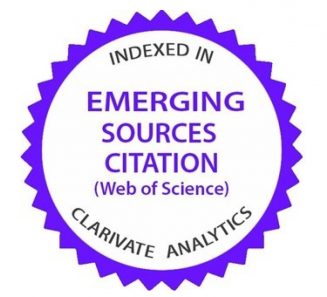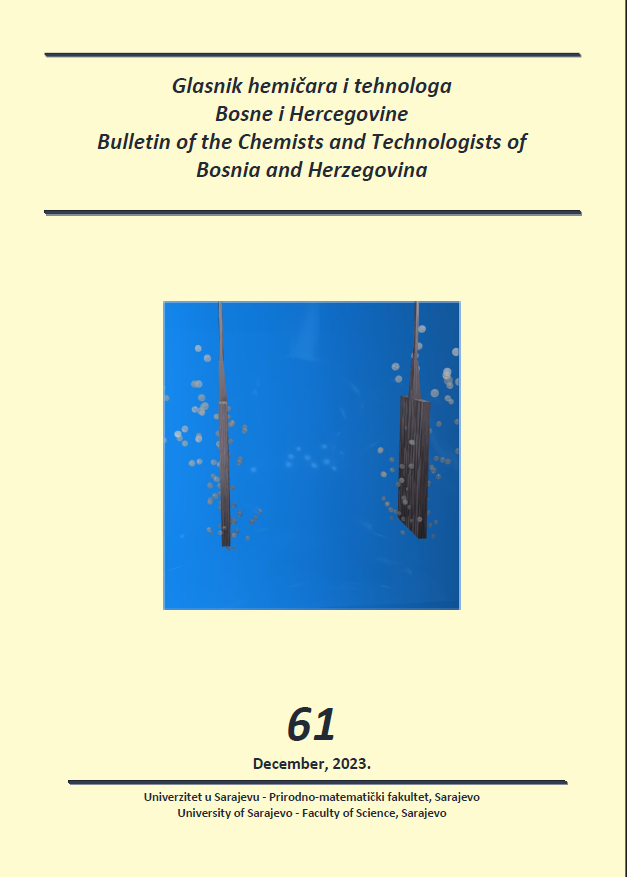|
|
Bulletin of the Chemists and Technologists of Bosnia and Herzegovina
Issue 61
Publication date: December 2023 |
|
Table of contents
Phytochemical analysis of eight Genista L. taxa (Fabaceae) from natural populations in Bosnia and Herzegovina Original Scientific Article
Pustahija, F., Bašić, N., Starčević, M., Subašić, M., Boškailo, A., Parić, A., Hukić, E.
DOI: 10.35666/2232-7266.2023.61.01
UDK: 547[582.916.26:543.063] (497.6)
Abstract: Phytochemical analysis of aerial parts of eight autochthonous Genista L. taxa (brooms; Fabaceae; G. germanica, G. januensis, G. pilosa, G. radiata, G. sagittalis, G. sericea, G. sylvestris ssp. dalmatica and G. tinctoria) from natural populations in Bosnia and Herzegovina was performed in this study. Using fast phytochemical methods, for the first time, emodin was identified in the genus; coumarins, fatty acids, saponins, steroids, tannins and terpenoids in some taxa, but also the presence of phenolic compounds or the absence of anthocyanins in all studied taxa. The analysis of total phenol (TPC), flavonoid (TFC), phenolic acids (TPA) and alkaloid (TA) contents and antioxidant activity (DPPH), determined by spectrophotometry method, indicated the existence of differences between the studied taxa (p<0.01). The taxa differed significantly from each other in TPA and TA, and the least in terms of antioxidant activity. There is a positive correlation between TPA, TPC and TFC in one hand, and TA and antioxidative activity in other (p<0.01). The Euclidean dendrogram indicates two main clusters: the first cluster includes G. januensis and G. pilosa, and the second is derived from the remaining six taxa. Obtained PCA clusters were more diffused than those generated by Euclidean distance dendrogram but in a good agreement with them. The obtained data indicate the need for further phytochemical and pharmacological research of the genus Genista, as a very interesting source of natural active compounds, as well as population research with special emphasis on the influence of microclimate on SMs content.
Bulletin of the Chemists and Technologists of Bosnia and Herzegovina 61, 1-9.
GHG emissions in the current and future MSW management system in Zvornik, Bosnia and Herzegovina Original Scientific Article
Bjelić, D., Malinović, B., Nešković Markić, D., Gegić, B.
DOI: 10.35666/2232-7266.2023.61.02
Abstract: Each and every step in the process of municipal solid waste (MSW) management generates the greenhouse gases (GHG). Therefore, it is imperative to focus on MSW from the source to the final waste disposal in order to decrease the negative impact on the environment. This study aims to calculate the GHG emissions at the present moment (Status Quo) for waste management as well as on the improved MSW management that should be implemented in this local community by 2027 (Scenario 2027). To visualize waste streams in these two scenarios, the STAN 2.5 software was used, and for the calculation of GHG emissions in the City of Zvornik, the IWM-2 software was used. The MSW management Status Quo is basically characterized by the collection communal of waste and its deposition on the landfill without a degasification system and landfill gas treatment. The guidelines and recommendations for MSW management improvement, Scenario 2027 propose the establishment of separate collections of secondary raw materials and biodegradable waste, and improved collection and treatment of landfill gas at the landfill site. The implementation of these measures would result in a reduction of approximately 40% in GHG emissions compared to the Status Quo. The most significant impact would be realized in the environment due to the collection and treatment of landfill.
Bulletin of the Chemists and Technologists of Bosnia and Herzegovina 61, 11-19.
Cyclosporine A concentrations in blood measured with the immunoassays on Roche e601® and ADVIA Centaur XP® analysers-what is the extent of the agreement? Original Scientific Article
Tijanić, A., Beletić, A., Stanković, S.
DOI: 10.35666/2232-7266.2023.61.03
UDK: 577.1[57.087.3:612.11]
Abstract: Monitoring of cyclosporine A (Cs A) concentrations is inevitable for efficient and safe immunosuppression. Currently, immunoassays are the most often used method. The study compared the Cs A concentrations in EDTA-blood samples of 50 patients, measured on Roche e601® and ADVIA Centaur XP® analyzers. The Cs A concentrations on e601® were between 30.00 and 573.00 ng/mL. On Centaur XP® they were in the range 30.2-395.2 ng/mL. For all data the correlation coefficient (95% confidence interval (CI)) was 0.98 (0.97-0.99), while in the groups with concentrations below and above 100 ng/mL it was 0.90 (0.74-0.93) and 0.98 (0.94-0.99), respectively. The slope (95% CI) in the Passing-Bablok analysis on all results was 0.73 (0.67-0.83), and the intercept (95% CI) was 12.53 (6.66-17.78). In the group with results below 100 ng/mL, the slope was 0.92 (0.77-1.12) and the intercept 3.05 (from -8.45 to 12.09). For the Cs A concentrations above 100 ng/mL the slope was 0.71 (0.64-0.84) and the intercept 9.31 (from -8.86 to 24.27). The proportional and systematic errors were present in a wide range of Cs A concentrations measured on the evaluated analyzers. The concordance was satisfactory for concentrations below 100 ng/mL.
Bulletin of the Chemists and Technologists of Bosnia and Herzegovina 61, 21-24.
Leachate of landfill Smiljevići (Sarajevo, BiH) and their environmental statusOriginal Scientific Article
Mahmutović, O., Prazina, N.
DOI: 10.35666/2232-7266.2023.61.04
UDK: 543.31[628.3:504](497.6 Smiljevići)
Abstract: Leachates are produced as a filtrate from waste landfills as a result of highly polluted waters. Organic substances that are mostly present are: phenolic compounds, halogen organic substances, oils and fats. The presence of nitrogen substances is significant, followed by phosphoric substances, sulfates, chlorides, and heavy metals. Sanitary landfill "Smiljevići", created 60 years ago, is placed on the hill area of Novi Grad municipality, Sarajevo. In that time area around landfill was very sparsely populated. Following the legislative, the leachate from the Smiljevići landfill does not have a good environmental status. On the other hand, according to global - typical values, contaminant concentrations are much closer to low than average values. The content of contaminants with long retention in nature and tendency to bioaccumulation is within legal limits. Most parameters that exceed the permitted values include usually biodegradable compounds that the stream of the river Bosnia can absorb better than the small ecosystem of the Lepenički creek. The problem is further aggravated bz the fact that the area surrounding the creek is now relatively densely populated, the stream has a small water capacity, especially in the summer, and the contaminants are mostly volatile. Finally, this problem also can be attributed to irresponsible activity of urban planning.
Bulletin of the Chemists and Technologists of Bosnia and Herzegovina 60, 25-31.




